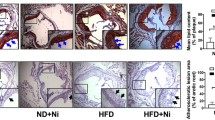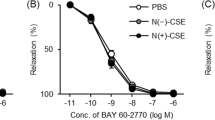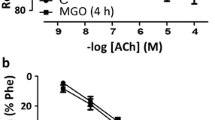Abstract
Nicotine exposure via cigarette smoking and tobacco chewing is associated with vascular complications. The present study investigated the effect of rosuvastatin in nicotine (2 mg/kg/day, i.p., 4 weeks)-induced vascular endothelial dysfunction (VED) in rats. The development of VED was assessed by employing isolated aortic ring preparation and estimating aortic and serum nitrite/nitrate concentration. Further, scanning electron microscopy and hematoxylin-eosin staining of thoracic aorta were performed to assess the vascular endothelial integrity. Moreover, oxidative stress was assessed by estimating aortic superoxide anion generation and serum thiobarbituric acid-reactive substances. The nicotine administration produced VED by markedly reducing acetylcholine-induced endothelium-dependent relaxation, impairing the integrity of vascular endothelium, decreasing aortic and serum nitrite/nitrate concentration, increasing oxidative stress, and inducing lipid alteration. However, treatment with rosuvastatin (10 mg/kg/day, i.p., 4 weeks) markedly attenuated nicotine-induced vascular endothelial abnormalities, oxidative stress, and lipid alteration. Interestingly, the co-administration of peroxisome proliferator-activated receptor γ (PPARγ) antagonist, GW9662 (1 mg/kg/day, i.p., 2 weeks) submaximally, significantly prevented rosuvastatin-induced improvement in vascular endothelial integrity, endothelium-dependent relaxation, and nitrite/nitrate concentration in rats administered nicotine. However, GW9662 co-administration did not affect rosuvastatin-associated vascular anti-oxidant and lipid-lowering effects. The incubation of aortic ring, isolated from rosuvastatin-treated nicotine-administered rats, with L-NAME (100 μM), an inhibitor of nitric oxide synthase (NOS), significantly attenuated rosuvastatin-induced improvement in acetylcholine-induced endothelium-dependent relaxation. Rosuvastatin prevents nicotine-induced vascular endothelial abnormalities by activating PPARγ and endothelial NOS signaling pathways. Moreover, the PPARγ-independent anti-oxidant and lipid-lowering effects of rosuvastatin might additionally play a role in the improvement of vascular endothelial function.









Similar content being viewed by others
Abbreviations
- ACh:
-
Acetylcholine
- SNP:
-
Sodium nitroprusside
- ANOVA:
-
Analysis of variance
- CPCSEA:
-
Committee for the purpose of control and supervision of experiments on animals
- DTPA:
-
Diethylenetriamine pentaacetic acid
- eNOS:
-
Endothelial nitric oxide synthase
- HMG-CoA reductase:
-
3-Hydroxy-3-methylglutaryl-coenzyme A
- L-NAME:
-
N(omega)-nitro-l-arginine methyl ester (L-NAME)
- NBT:
-
Nitroblutetrazolium
- NO:
-
Nitric oxide
- PPARγ:
-
Peroxisome proliferator-activated receptor γ
- TBARS:
-
Thiobarbituric acid-reactive substances
- VED:
-
Vascular endothelial dysfunction
References
Czernin J, Waldherr C (2003) Cigarette smoking and coronary blood flow. Prog Cardiovasc Dis 45:395–404
Ambrose JA, Barua RS (2004) The pathophysiology of cigarette smoking and cardiovascular disease: an update. J Am Coll Cardiol 43:1731–1737
Gupta BK, Kaushik A, Panwar RB et al (2007) Cardiovascular risk factors in tobacco-chewers: a controlled study. J Assoc Physicians India 55:27–31
Celermajer DS, Adams MR, Clarkson P et al (1996) Passive smoking and impaired endothelium-dependent arterial dilatation in healthy young adults. N Engl J Med 334:150–154
Raupach T, Schäfer K, Konstantinides S et al (2006) Secondhand smoke as an acute threat for the cardiovascular system: a change in paradigm. Eur Heart J 27:386–392
Neunteufl T, Heher S, Kostner K et al (2002) Contribution of nicotine to acute endothelial dysfunction in long-term smokers. J Am Coll Cardiol 39:251–256
Catanzaro DF, Zhou Y, Chen R et al (2007) Potentially reduced exposure cigarettes accelerate atherosclerosis: evidence for the role of nicotine. Cardiovasc Toxicol 7:192–201
Balakumar P, Kaur J (2009) Is nicotine a key player or spectator in the induction and progression of cardiovascular disorders? Pharmacol Res 60:361–368
Toda N, Toda H (2010) Nitric oxide-mediated blood flow regulation as affected by smoking and nicotine. Eur J Pharmacol 649:1–13
Desjardins F, Balligand JL (2006) Nitric oxide-dependent endothelial function and cardiovascular disease. Acta Clin Belg 61:326–334
Balakumar P, Kaur T, Singh M (2008) Potential target sites to modulate vascular endothelial dysfunction: current perspectives and future directions. Toxicology 245:49–64
Luo HL, Zang WJ, Lu J et al (2006) The protective effect of captopril on nicotine-induced endothelial dysfunction in rat. Basic Clin Pharmacol Toxicol 99:237–245
Balakumar P, Sharma R, Singh M (2008) Benfotiamine attenuates nicotine and uric acid-induced vascular endothelial dysfunction in the rat. Pharmacol Res 58:356–363
Kaur J, Reddy K, Balakumar P (2010) The novel role of fenofibrate in preventing nicotine- and sodium arsenite-induced vascular endothelial dysfunction in the rat. Cardiovasc Toxicol 10:227–238
Rodella LF, Favero G, Rossini C et al (2010) Endothelin-1 as a potential marker of melatonin’s therapeutic effects in smoking-induced vasculopathy. Life Sci 87:558–564
Xiao D, Huang X, Yang S et al (2011) Antenatal nicotine induces heightened oxidative stress and vascular dysfunction in rat offspring. Br J Pharmacol 164:1400–1409
Osende JI, Ruiz-Ortega M, Blanco-Colio LM et al (2004) Statins to prevent cardiovascular events in hypertensive patients. The ASCOT-LLA study. Nephrol Dial Transpl 19:528–531
Cui Y, Watson DJ, Girman CJ et al (2009) Effects of increasing high-density lipoprotein cholesterol and decreasing low-density lipoprotein cholesterol on the incidence of first acute coronary events (from the Air Force/Texas Coronary Atherosclerosis Prevention Study). Am J Cardiol 104:829–834
Devaraj S, Siegel D, Jialal I (2011) Statin therapy in metabolic syndrome and hypertension post-JUPITER: what is the value of CRP? Curr Atheroscler Rep 13:31–42
Balakumar P, Kathuria S, Taneja G et al (2012) Is targeting eNOS a key mechanistic insight of cardiovascular defensive potentials of statins? J Mol Cell Cardiol 52:83–92
Jones SP, Gibson MF, Rimmer DM III et al (2002) Direct vascular and cardioprotective effects of rosuvastatin, a new HMG-CoA reductase inhibitor. J Am Coll Cardiol 40:1172–1178
Rosenson RS (2003) Rosuvastatin: a new inhibitor of HMG-coA reductase for the treatment of dyslipidemia. Expert Rev Cardiovasc Ther 1:495–505
Ott C, Schneider MP, Schlaich MP et al (2012) Rosuvastatin improves pulse wave reflection by restoring endothelial function. Microvasc Res 84:60–64
Suh JW, Choi DJ, Chang HJ et al (2010) HMG-CoA reductase inhibitor improves endothelial dysfunction in spontaneous hypertensive rats via down-regulation of caveolin-1 and activation of endothelial nitric oxide synthase. J Korean Med Sci 25:16–23
Cho DH, Choi YJ, Jo SA et al (2004) Nitric oxide production and regulation of endothelial nitric-oxide synthase phosphorylation by prolonged treatment with troglitazone: evidence for involvement of peroxisome proliferator-activated receptor (PPAR) gamma-dependent and PPARgamma-independent signaling pathways. J Biol Chem 279:2499–2506
Polikandriotis JA, Mazzella LJ, Rupnow HL et al (2005) Peroxisome proliferator-activated receptor gamma ligands stimulate endothelial nitric oxide production through distinct peroxisome proliferator-activated receptor gamma-dependent mechanisms. Arterioscler Thromb Vasc Biol 25:1810–1816
Balakumar P, Kathuria S (2012) Submaximal PPARγ activation and endothelial dysfunction: new perspectives for the management of cardiovascular disorders. Br J Pharmacol 166:1981–1992
Desjardins F, Sekkali B, Verreth W et al (2008) Rosuvastatin increases vascular endothelial PPARgamma expression and corrects blood pressure variability in obese dyslipidaemic mice. Eur Heart J 29:128–137
Shchukin IuV, D’iachkov VA, Seleznev EI et al (2008) Molecular mechanisms of effects of rosuvastatin on systemic oxidative stress and endogenous inflammation in patients with atherosclerosis. Kardiologiia 48:41–45
Sicard P, Delemasure S, Korandji C et al (2008) Anti-hypertensive effects of rosuvastatin are associated with decreased inflammation and oxidative stress markers in hypertensive rats. Free Radic Res 42:226–236
Tian XY, Wong WT, Xu A et al (2011) Rosuvastatin improves endothelial function in db/db mice: role of angiotensin II type 1 receptors and oxidative stress. Br J Pharmacol 164:598–606
Mittra S, Singh M (1998) Possible mechanism of captopril induced endothelium-dependent relaxation in isolated rabbit aorta. Mol Cell Biochem 183:63–67
Shah DI, Singh M (2006) Involvement of Rho-kinase in experimental vascular endothelial dysfunction. Mol Cell Biochem 283:191–199
Sastry KV, Moudgal RP, Mohan J et al (2002) Spectrophotometric determination of serum nitrite and nitrate by copper–cadmium alloy. Anal Biochem 306:79–82
Higo K, Karasawa A, Kubo K (1992) Protective effects of benidipine hydrochloride (KW-3049), a calcium antagonist, against experimental arterial calcinosis and endothelial dysfunction in rats. J Pharmacobiodyn 15:113–120
Kaur T, Goel RK, Balakumar P (2010) Effect of rosiglitazone in sodium arsenite-induced experimental vascular endothelial dysfunction. Arch Pharmacal Res 33:611–618
Sena CM, Matafome P, Crisóstomo J et al (2012) Methylglyoxal promotes oxidative stress and endothelial dysfunction. Pharmacol Res 65:497–506
Wang HD, Pagano PJ, Du Y et al (1998) Superoxide anion from the adventitia of the rat thoracic aorta inactivates nitric oxide. Circ Res 82:810–818
Kanie N, Kamata K (2002) Effects of chronic administration of the novel endothelin antagonist J-104132 on endothelial dysfunction in streptozotocin-induced diabetic rat. Br J Pharmacol 135:1935–1942
Ma FX, Liu LY, Xiong XM (2003) Protective effects of lovastatin on vascular endothelium injured by low density lipoprotein. Acta Pharmacol Sin 24:1027–1032
Puddu P, Puddu GM, Zaca F et al (2000) Endothelial dysfunction in hypertension. Acta Cardiol 55:221–232
Leesnitzer LM, Parks DJ, Bledsoe RK et al (2002) Functional consequences of cysteine modification in the ligand binding sites of peroxisome proliferator activated receptors by GW9662. Biochemistry 41:6640–6650
Kobayashi N, Ohno T, Yoshida K et al (2008) Cardioprotective mechanism of telmisartan via PPAR-gamma-eNOS pathway in dahl salt-sensitive hypertensive rats. Am J Hypertens 21:576–581
Toba H, Tojo C, Wang J et al (2012) Telmisartan inhibits vascular dysfunction and inflammation via activation of peroxisome proliferator-activated receptor-γ in subtotal nephrectomized rat. Eur J Pharmacol 685:91–98
Ríos-Vázquez R, Marzoa-Rivas R, Gil-Ortega I et al (2006) Peroxisome proliferator-activated receptor-gamma agonists for management and prevention of vascular disease in patients with and without diabetes mellitus. Am J Cardiovasc Drugs 6:231–242
Yu J, Zhang Z, Li Z et al (2010) Peroxisome proliferator-activated receptor-gamma (PPARgamma) agonist improves coronary artery endothelial function in diabetic patients with coronary artery disease. J Int Med Res 38:86–94
Balakumar P, Mahadevan N (2012) Interplay between statins and PPARs in improving cardiovascular outcomes: a double-edged sword? Br J Pharmacol 165:373–379
Montagnani M, Chen H, Barr VA et al (2001) Insulin-stimulated activation of eNOS is independent of Ca2+ but requires phosphorylation by Akt at Ser(1179). J Biol Chem 276:30392–30398
Balakumar P, Taneja G (2012) Fish oil and vascular endothelial protection: bench-to-bedside. Free Radic Biol Med 53:271–279
Van Boven AJ, Jukema JW, Paoletti R (1994) Endothelial dysfunction and dyslipidemia: possible effects of lipid lowering and lipid modifying therapy. Pharmacol Res 29:261–272
Lee IK, Kim HS, Bae JH (2002) Endothelial dysfunction: its relationship with acute hyperglycaemia and hyperlipidemia. Int J Clin Pract Suppl 129:59–64
Shah DI, Singh M (2006) Effect of bis(maltolato) oxovanadium on experimental vascular endothelial dysfunction. Naunyn Schmiedebergs Arch Pharmacol 373:221–229
Shah DI, Singh M (2006) Effect of fasudil on macrovascular disorder-induced endothelial dysfunction. Can J Physiol Pharmacol 84:835–845
Koh KK, Han SH, Quon MJ (2005) Inflammatory markers and the metabolic syndrome: insights from therapeutic interventions. J Am Coll Cardiol 46:1978–1985
Savoia C, Schiffrin EL (2007) Vascular inflammation in hypertension and diabetes: molecular mechanisms and therapeutic interventions. Clin Sci 112:375–384
Stalker TJ, Lefer AM, Scalia R (2001) A new HMG-CoA reductase inhibitor, rosuvastatin, exerts anti-inflammatory effects on the microvascular endothelium: the role of mevalonic acid. Br J Pharmacol 133:406–412
Fadini GP, Albiero M, Boscaro E et al (2010) Rosuvastatin stimulates clonogenic potential and anti-inflammatory properties of endothelial progenitor cells. Cell Biol Int 34:709–715
Reiss AB, Vagell ME (2006) PPARgamma activity in the vessel wall: anti-atherogenic properties. Curr Med Chem 13:3227–3238
Duan SZ, Usher MG, Mortensen RM (2008) Peroxisome proliferator-activated receptor-gamma-mediated effects in the vasculature. Circ Res 102:283–294
Acknowledgments
We express our gratitude to Dr. Rajendar Singh Sra, M.D., Chairman, and Shri Om Parkash, Director, Rajendra Institute of Technology and Sciences, Sirsa, India, for their constant support for this study. We extend our gratitude to Mr. Sanjeev Kalra for his support during this study. We express our sincere thanks to the Indian Agricultural Research Institute for having carried out the scanning electron microscopic study.
Conflict of interest
No conflict of interest has been declared.
Author information
Authors and Affiliations
Corresponding author
Rights and permissions
About this article
Cite this article
Kathuria, S., Mahadevan, N. & Balakumar, P. Possible involvement of PPARγ-associated eNOS signaling activation in rosuvastatin-mediated prevention of nicotine-induced experimental vascular endothelial abnormalities. Mol Cell Biochem 374, 61–72 (2013). https://doi.org/10.1007/s11010-012-1505-6
Received:
Accepted:
Published:
Issue Date:
DOI: https://doi.org/10.1007/s11010-012-1505-6




